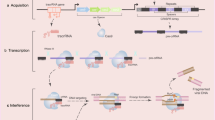Abstract
Three 6-thioguanine-resistant mutants of the human diploid lymphoblast line MGL-8 were studied. The inactivation by heat of both HGPRT activity and antigenicity of the HGPRT immunologically cross-reacting material of the A30 mutant cells were not protected by PRPP, indicating that the HGPRT in A30 cells has an altered PRPP binding site, leading to lack of stabilization and rapid degradation of the enzyme. Two dimensional separations of the immunoprecipitates from extracts of the parental and mutant cell lines showed that the A35 mutant CRM has a more acidic isoelectric pH, while the A30 CRM has a more basic isoelectric pH and that the A30 protein has a faster rate of degradation than the wild-type HGPRT. The A30 CRM also has a smaller molecular size than the wild-type enzyme.
Similar content being viewed by others
Literature cited
Epstein, J., Leyva, A., Kelly, W. M., and Littlefield, J. W. (1977).Somat. Cell Genet. 3:135–148.
Arnold, W. J., Mead, J. C., and Kelly, W. N. (1972).J. Clin. Invest. 51:1805–1812.
Ghangas, G. S., and Millman, G. (1975).Proc. Natl. Acad. Sci. U.S.A. 72:4147–4150.
Szybalski, W., Szybalska, E. H., and Ragni, G. (1962).Natl. Cancer Inst. Monogr. 7:75–89.
Littlefield, J. W. (1966).Exp. Cell Res. 41:190–196.
Fox, I. H., and Kelly, W. N. (1971).J. Biol. Chem. 246:5739–5748.
Kizaki, H., and Sakurada, T. (1977).J. Lab. Clin. Med. 89:1135–1144.
Millman, G., Lee, E., Ghangas, G. S., McLaughlin, J., and George, M., Jr. (1976).Proc. Natl. Acad. Sci. U.S.A. 73:4589–4593.
Ghangas, G. A., and Millman, G. (1977).Science 196:1119–1120.
Goldberg, A. L. (1972).Proc. Natl. Acad. Sci. U.S.A. 69:422–426.
Lin, S., and Zabin, J. (1973).J. Biol. Chem. 247:2205–2211.
Capecchi, M. R., Capecchi, N. E., Hughes, S. H., and Wahl, G. H. (1974).Proc. Natl. Acad. Sci. U.S.A. 71:4732–4736.
Arnold, W. J., and Kelly, W. N. (1971).J. Biol. Chem. 246:7398–7404.
Olsen, A. S., and Millman, G. (1974).J. Biol. Chem. 249:4030–4037.
Greene, M. L., Boyle, J. A., and Seegmiller, J. E. (1970).Science 167:887–889.
Millman, G., Krauss, S. W., and Olsen, A. S. (1977).Proc. Natl. Acad. Sci. U.S.A. 74:926–930.
Pine, M. J. (1972).Annu. Rev. Microbiol. 26:103–126.
Goldbert, A. L., Howell, E. M., Li, E. B., Martel, S. B., and Proutz, W. F. (1974).Fed. Proc. 33:1112–1120.
Author information
Authors and Affiliations
Rights and permissions
About this article
Cite this article
Epstein, J., Ghangas, G.S., Leyva, A. et al. Analysis of HGPRT− CRM+ human lymphoblast mutants. Somat Cell Mol Genet 5, 809–820 (1979). https://doi.org/10.1007/BF01542643
Received:
Issue Date:
DOI: https://doi.org/10.1007/BF01542643




